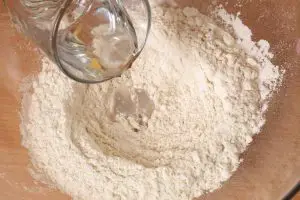If you make bread from scratch or buy it at your local farmers’ market, you already know that a good bread bag is perfect for storing fresh bread. While plastic bags are acceptable for the sandwich bread you buy at the store, homemade breads with crusts will get soggy if you use these types of bags.
When you shop for bread bags, you’ll come across two main types: those made out of linen and those made out of cotton. Since both types have their pros and cons, it’s up to you to decide which one is right for you, and below are some details to help you do just that.
Benefits of Linen Bread Bags
Linen is known for its strength and durability, as well as its ability to whisk moisture away from your loaf of bread. It is more expensive than cotton because the process for turning flax fibers into linen is much more complex than the process to make cotton. It simply takes more work to produce a piece of linen than it does to produce a piece of cotton fabric. Linen has also been around for a while, with strips of linen even being found in some Egyptian tombs.
As far as its traits are concerned, linen tends to do better than cotton when it comes to bread bags simply because linen:
- Is more breathable than cotton, since it is made out of hollow fibers
- Absorbs even better than cotton does
- Tends to be stronger and more durable than cotton
Benefits of Cotton Bread Bags
Cotton is made from the cotton plant, which is a natural, soft-fiber material that is easy to make and is low-maintenance. Cotton is also very versatile and can be spun and woven to make many different types of cotton materials. Cotton comes in many different blends, from a sheer lightweight cotton to cotton that is heavier and more densely woven. When it comes to how breathable cotton is, the weave of the cotton will determine its rate of breathability.
Some of the traits associated with cotton as it relates to bread bags include:
- Cotton is much less expensive than linen is, the latter sometimes being very pricey
- Cotton is much easier to care for than linen is
- While both cotton and linen are highly absorbent, cotton can hold roughly 25% of its weight in water, while linen holds roughly 20%, which makes cotton a little more absorbent than linen
How Linen or Cotton Helps Keep Bread Fresh?
In order for bread to remain fresh, it has to be neither too moist nor too dry. Either of these will make bread moldy and speed up its demise. Some of the things that cause bread to go bad are wrapping it in plastic, which doesn’t allow the bread to breathe and therefore increases the moisture content, and wrapping your bread before it has a chance to cool fully, which can make it turn moldy.
In addition, too much air circulation causes the tender center of the bread to evaporate, which then causes it to become dry and stale. Because both linen and cotton bread bags are breathable and whisk moisture away from the bread, you can place loaves of bread in these types of bags and then seal them shut.
Afterwards, storing them in a cool dry place always works best. In fact, the darker and cooler the location is, the better your bread will taste when you cut into it and slice it up for your next sandwich or some toast. Keep in mind that because homemade bread has no preservatives in it, it is still not very likely to last more than two to three days, but during that time, it will taste delicious and have the perfect texture!
How to Store Your Homemade Bread?
Keeping homemade bread fresh is easier than you think. While both linen and cotton bread bags work great on fresh bread, many people have a slight preference for linen bags simply because they are a bit more breathable, more durable, and more absorbent.
If you’re not going to eat your homemade bread in two to three days, here are some things that you can do to make it last a bit longer:
- Wrap the bread carefully, then freeze it. For entire loaves, it’s best to slice the bread first.
- If you don’t have a linen or cotton bag, any cloth bag will do in a pinch. Just make sure that no area of the bread loaf is exposed to any air.
- Cut from the middle of the loaf first, since the cut end of the bread usually dries out first. When you’re done, place the two ends facing one another.
- Store homemade bread in a dry place, which means not the refrigerator, where it’s moist and damp most of the time.
If you do choose to use a linen bag, you might want to sprinkle some flour inside the bag first. This helps to whisk away moisture even more so that your bread doesn’t get moldy. While many people prefer linen bread bags, there are still a lot of advantages to using cotton bags instead. If you live in an area that is humid much of the time, the choice you end up making is even more important.
You could always try both types of bags to determine which one works best where you live. Both linen and cotton bread bags work great with fresh homemade bread, so one of these types should always be used when you have this type of bread around the house.






